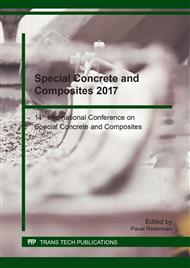p.199
p.204
p.213
p.219
p.225
p.231
p.239
p.245
p.251
Utilization of Surface-Modified Polymer and Glass Micro-Fibers as Reinforcement in Cement Composites
Abstract:
The presented work focuses on plasma modifications of polymer and glass micro-fibers (having 32 and 14 μm in the diameter, respectively) used as randomly distributed and oriented reinforcement of concrete composites. Fiber surfaces were modified by means of the low-pressure coupled cold oxygen plasma in order to attain a strong adhesion with the cement matrix. From the perspective of micro scale, an impact of modifications on both the physical and the chemical surface changes of treated fibers was examined using: (i) a wettability measurements – an evaluation of an interphase interaction between demineralized water and fibers and (ii) the SEM microscopy – an assessment of a surface morphology. From the perspective of macro scale, the interaction between the two materials was examined by destructive four-point bending tests of the cement paste containing both the reference and treated fibers (specimens having dimensions equal to 40×40×160 mm, water to cement ration 0.4) were done. It was shown that the wettability of modified fibers was increased by approx. 10 % and 70 % in the case of glass and polymer fibers, respectively. The SEM morphology analysis revealed fine roughening of treated fibers, if compared to the reference ones. The mechanical testing pointed out on a toughness increase in the post-cracking response of loaded specimens.
Info:
Periodical:
Pages:
225-230
Citation:
Online since:
January 2018
Authors:
Price:
Сopyright:
© 2018 Trans Tech Publications Ltd. All Rights Reserved
Share:
Citation:


